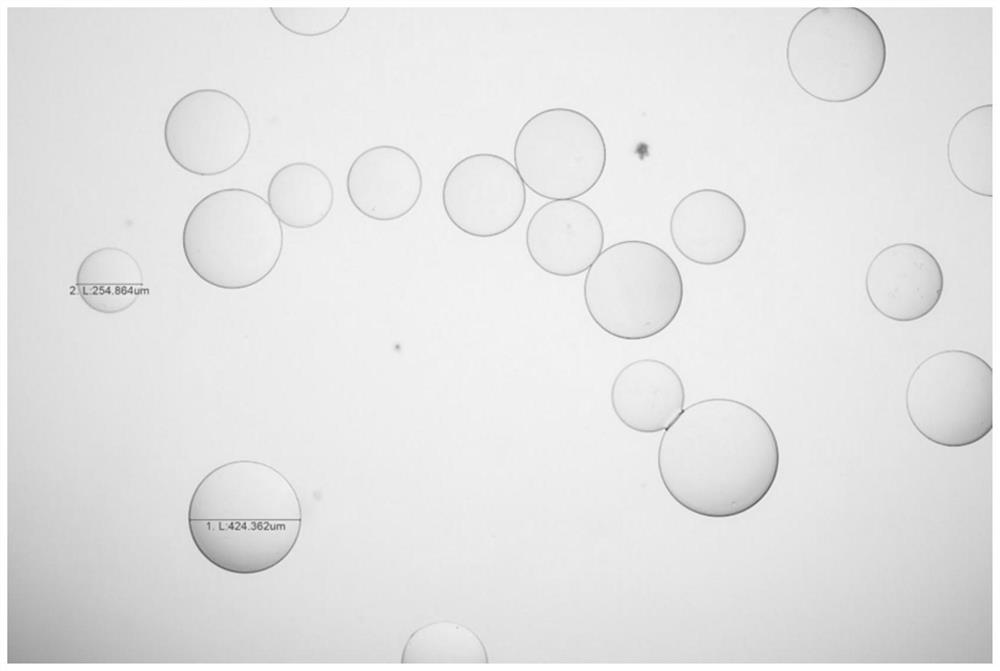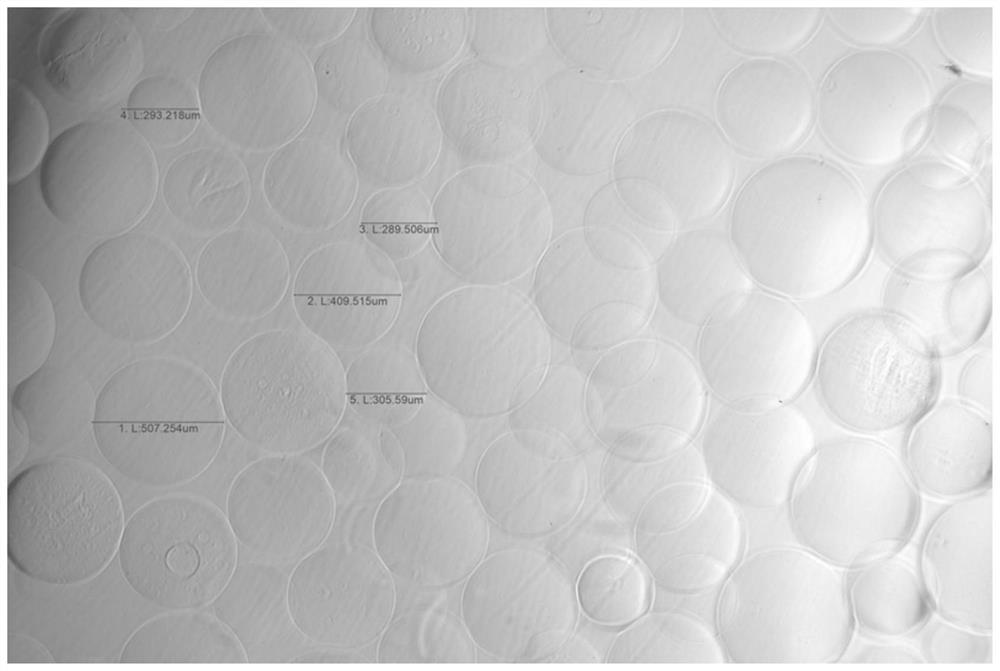Photo-initiated cross-linked polyvinyl alcohol drug-loaded embolism microsphere and preparation method thereof
A technology for cross-linking polyvinyl alcohol and polyvinyl alcohol is applied in the field of medical materials to achieve the effects of good spheroidization, simple equipment and better drug-carrying effect.
- Summary
- Abstract
- Description
- Claims
- Application Information
AI Technical Summary
Problems solved by technology
Method used
Image
Examples
Embodiment 1
[0035] S1. Synthesis of photocrosslinkable polyvinyl alcohol intermediates by acid catalysis
[0036] 100 g of purified water and 12 g of polyvinyl alcohol with a weight average molecular weight of 67,000 were added to the reaction flask, and heated to 95° C. to completely dissolve the polyvinyl alcohol. Add 1.5g N-(2,2-dimethoxyethyl)-2-acrylamide and 20mL concentrated hydrochloric acid, and react at 30°C for 4 hours. The pH was adjusted to 7. Finally, the solution was concentrated to a viscosity of 1800 cps to obtain about 40 g of the microsphere intermediate.
[0037] S2. Preparation of polyvinyl alcohol embolization microspheres by photoinitiated crosslinking
[0038] Add 9g microsphere intermediates, 0.6g 2-acrylamide-2-methylpropanesulfonic acid sodium salt, 0.09g 2-hydroxyl-2-methyl-1-[4-( 2-hydroxyethoxy)phenyl]-1-propanone, then add 5mL water to dissolve completely. Then add 60mL of butyl acetate and 0.4g of cellulose acetate butyrate, stir to form a suspension, a...
Embodiment 2
[0040] S1. Synthesis of photocrosslinkable polyvinyl alcohol intermediates by acid catalysis
[0041] Add 1,000 g of purified water and 300 g of polyvinyl alcohol with a weight average molecular weight of 35,000 into the reaction flask, and heat to 85° C. to completely dissolve the polyvinyl alcohol. Add 100g N-(2,2-dimethoxyethyl)-2-acrylamide and 150mL concentrated hydrochloric acid, and react at 20°C for 5 hours. After the reaction, adjust the pH of the reaction system with 1mol / L sodium hydroxide solution Adjust to 7.5. Finally, the solution was concentrated to a viscosity of 2000 cps to obtain 900 g of microsphere intermediates.
[0042]S2. Preparation of polyvinyl alcohol embolization microspheres by photoinitiated crosslinking
[0043] Add 100g microsphere intermediate, 20g 2-acrylamide-2-methylpropanesulfonic acid sodium salt, 2g 2-hydroxyl-2-methyl-1-[4-(2- Hydroxyethoxy)phenyl]-1-propanone, 0.3g N-vinylpyrrolidone, and then add 20mL water to dissolve completely. ...
Embodiment 3
[0045] S1. Synthesis of photocrosslinkable polyvinyl alcohol intermediates by base catalysis
[0046] Add 600 mL of dimethyl sulfoxide and 100 g of polyvinyl alcohol with a weight average molecular weight of 78,000 to the reaction flask, and heat to 80° C. to completely dissolve the polyvinyl alcohol. 5 g of glycidyl methacrylate and 10 mL of tetramethylethylenediamine were added, and the reaction was stirred at 60° C. for 5 hours. After the reaction is finished, ethanol as a precipitating agent is added to the reaction system to precipitate the modified polyvinyl alcohol. The modified polyvinyl alcohol was obtained after filtration, and redissolved to form a 23% polyvinyl alcohol aqueous solution as a photocrosslinkable polyvinyl alcohol intermediate.
[0047] S2. Preparation of polyvinyl alcohol embolization microspheres by photoinitiated crosslinking
[0048] 20g of the above-mentioned polyvinyl alcohol intermediate, 0.34g of 2-acrylamide-2-methylpropanesulfonic acid sodi...
PUM
 Login to View More
Login to View More Abstract
Description
Claims
Application Information
 Login to View More
Login to View More - R&D
- Intellectual Property
- Life Sciences
- Materials
- Tech Scout
- Unparalleled Data Quality
- Higher Quality Content
- 60% Fewer Hallucinations
Browse by: Latest US Patents, China's latest patents, Technical Efficacy Thesaurus, Application Domain, Technology Topic, Popular Technical Reports.
© 2025 PatSnap. All rights reserved.Legal|Privacy policy|Modern Slavery Act Transparency Statement|Sitemap|About US| Contact US: help@patsnap.com



